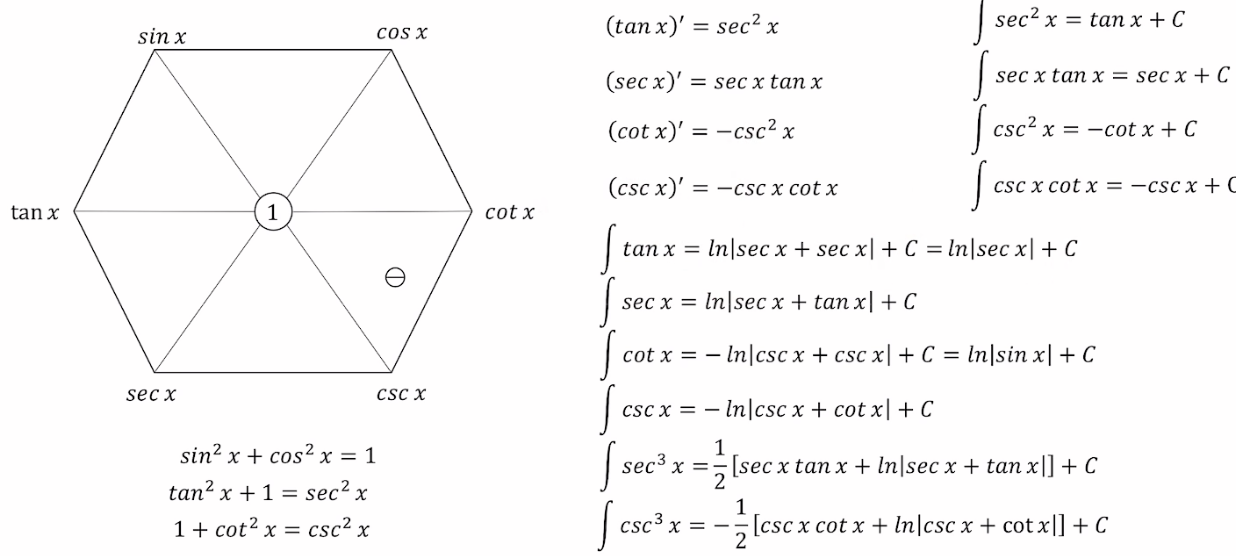三角学、微积分和工程中的余切函数图像:揭开函数的应用之谜
发布时间: 2024-07-10 02:38:12 阅读量: 132 订阅数: 38 


# 1. 余切函数的数学基础**
余切函数(tan),是三角学中一个重要的函数,定义为对边与邻边的比值。它与正弦函数(sin)和余弦函数(cos)密切相关,是三角恒等式和微积分中的关键函数。
在直角三角形中,余切函数表示斜边与对角的比值,即:tan θ = 对边 / 邻边。余切函数的范围为实数集,其图像是一个周期性函数,在奇数倍 π / 2 处有垂直渐近线。
# 2.1 微分和积分中的余切函数
### 2.1.1 余切函数的导数和积分
**导数:**
余切函数的导数由下式给出:
```
f(x) = tan(x)
f'(x) = sec^2(x)
```
**积分:**
余切函数的积分由下式给出:
```
∫ tan(x) dx = ln|sec(x)| + C
```
其中,C 是积分常数。
### 2.1.2 余切函数在极限和连续性中的应用
**极限:**
* 当 x 趋近于 π/2 时,tan(x) 趋近于无穷大。
* 当 x 趋近于 -π/2 时,tan(x) 趋近于负无穷大。
**连续性:**
余切函数在实数集上是连续的,除了在奇异点 x = π/2 和 x = -π/2。
**参数说明:**
* **x:**自变量,表示弧度。
**代码块:**
```python
import numpy as np
# 计算余切函数的导数
x = np.linspace(-np.pi/2, np.pi/2, 100)
y = np.tan(x)
dydx = np.gradient(y, x)
# 绘制余切函数及其导数
import matplotlib.pyplot as plt
plt.plot(x, y, label="tan(x)")
plt.plot(x, dydx, label="d/dx tan(x)")
plt.legend()
plt.show()
```
**逻辑分析:**
* 使用 NumPy 库生成自变量 x 的值域。
* 计算余切函数 y 和其导数 dydx。
* 使用 Matplotlib 绘制余切函数及其导数的图像。
**表格:**
| **性质** | **余切函数** |
|---|---|
| 导数 | sec^2(x) |
| 积分 | ln|sec(x)| + C |
| 极限 | x → π/2: ∞, x → -π/2: -∞ |
| 连续性 | 实数集上连续,奇异点 x = π/2 和 x = -π/2 |
# 3.1 电路分析中的余切函数
#### 3.1.1 交流电路中的阻抗和相位角
在交流电路中,余切函数用于计算阻抗和相位角。阻抗是电路对交流电阻抗,相位角是电流和电压之间的相位差。
**阻抗计算:**
在交流电路中,阻抗 Z 由电阻 R、电感 L 和电容 C 决定,其计算公式为:
```
Z = √(R^2 + (XL - XC)^2)
```
其中:
* XL = ωL 是电感感抗,ω 是角频率
* XC = 1/(ωC) 是电容容抗
**相位角计算:**
相位角 φ 由阻抗 Z 和电感感抗 XL 与电容容抗 XC 之差决定,其计算公式为:
```
φ = arctan((XL - XC) / R)
```
#### 3.1.2 余切函数在谐振频率和品质因数中的应用
**谐振频率:**
谐振频率是电路中阻抗最小的频率,此时电感感抗和电容容抗相等。谐振频率 f0 的计算公式为:
```
f0 = 1/(2π√LC)
```
**品质因数:**
品质因数 Q 是衡量电路选择性的一种指标,其计算公式为:
```
Q = ω0L/R
```
其中 ω0 是谐振角频率。
品质因数越高,电路选择性越好,即电路对特定频率的响应更强。
# 4. 余切函数的图形化表示
### 4.1 余切函数的图像绘制
#### 4.1.1 余切函数的周期性和奇偶性
余切函数是一个周期函数,其周期为 π。这意味着对于任何实数 x,都有 tan(x + π) = tan(x)。
余切函数也是一个奇函数,这意味着对于任何实数 x,都有 tan(-x) = -tan(x)。
#### 4.1.2 余切函数的渐近线和拐点
余切函数有两个垂直渐近线,分别为 x = π/2 和 x = 3π/2。这些渐近线表示余切函数在这些点处不存在。
余切函数在 x = 0 处有一个拐点。在拐点处,余切函数的导数为 0,并且函数的曲率发生变化。
### 4.2 余切函数图像的变换
#### 4.2.1 平移、缩放和反射变换
余切函数图像可以通过平移、缩放和反射进行变换。
* 平移:通过添加或减去常数来平移余切函数图像。
* 缩放:通过乘以常数来缩放余切函数图像。
* 反射:通过在 x 轴或 y 轴上反射余切函数图像。
#### 4.2.2 余切函数图像的组合和反函数
余切函数图像可以通过组合和反函数进行变换。
* 组合:通过将余切函数与其他函数组合来创建新的函数。
* 反函数:通过求余切函数的反函数来创建新的函数。
### 代码示例
```python
import numpy as np
import matplotlib.pyplot as plt
# 绘制余切函数图像
x = np.linspace(-np.pi, np.pi, 100)
y = np.tan(x)
plt.plot(x, y)
plt.xlabel('x')
plt.ylabel('tan(x)')
plt.title('余切函数图像')
plt.show()
```
**代码逻辑分析:**
* `np.linspace(-np.pi, np.pi, 100)` 创建一个从 -π 到 π 的 100 个点的均匀间隔数组。
* `np.tan(x)` 计算数组中每个点的余切值。
* `plt.plot(x, y)` 绘制余切函数图像。
* `plt.xlabel('x')` 和 `plt.ylabel('tan(x)')` 设置 x 轴和 y 轴的标签。
* `plt.title('余切函数图像')` 设置图像的标题。
* `plt.show()` 显示图像。
### 表格示例
| 变换类型 | 变换公式 |
|---|---|
| 平移 | tan(x + c) |
| 缩放 | tan(cx) |
| 反射(x 轴) | -tan(x) |
| 反射(y 轴) | tan(-x) |
### 流程图示例
```mermaid
graph LR
subgraph 余切函数图像的变换
A[平移] --> B[缩放]
B --> C[反射]
C --> D[组合]
D --> E[反函数]
end
```
# 5. 余切函数的应用拓展**
### 5.1 余切函数在信号处理中的应用
#### 5.1.1 傅里叶变换中的余切函数
傅里叶变换是一种将时域信号转换为频域表示的数学工具。余切函数在傅里叶变换中扮演着重要角色,它可以用来表示奇偶信号的虚部。
对于一个实值信号 `x(t)`,其傅里叶变换为:
```
X(f) = ∫[-∞,∞] x(t) e^(-2πift) dt
```
其中 `f` 是频率。
如果 `x(t)` 是一个奇函数,即 `x(-t) = -x(t)`,那么其傅里叶变换的虚部为:
```
Im[X(f)] = ∫[-∞,∞] x(t) sin(2πift) dt
```
此时,余切函数 `cot(πf)` 可以用来表示虚部:
```
Im[X(f)] = 2cot(πf) ∫[0,∞] x(t) cos(2πift) dt
```
#### 5.1.2 余切函数在滤波器设计中的作用
余切函数在滤波器设计中也具有重要应用。例如,在带通滤波器中,余切函数可以用来实现带通响应。
一个带通滤波器的传递函数可以表示为:
```
H(f) = cot(π(f - f0)/B)
```
其中 `f0` 是中心频率,`B` 是带宽。
该滤波器将通过中心频率 `f0` 附近的频率成分,而抑制其他频率成分。
### 5.2 余切函数在计算机图形学中的应用
#### 5.2.1 3D建模中的余切函数
在3D建模中,余切函数可以用来计算曲面上的法线向量。法线向量对于光照和阴影计算至关重要。
对于一个曲面 `S` 上的点 `p`,其法线向量 `n` 可以表示为:
```
n = cot(α) * (∂S/∂x) × (∂S/∂y)
```
其中 `α` 是曲面在点 `p` 处的法线角,`∂S/∂x` 和 `∂S/∂y` 是曲面在 `x` 和 `y` 方向上的偏导数。
#### 5.2.2 余切函数在光线追踪和渲染中的作用
在光线追踪和渲染中,余切函数可以用来计算光线与曲面的交点。
对于一条光线 `r` 和一个曲面 `S`,其交点 `p` 可以表示为:
```
p = r(t)
```
其中 `t` 是光线与曲面相交的参数。
通过求解以下方程,可以得到 `t` 的值:
```
cot(α) * (r(t) - S(p)) · (∂S/∂x) × (∂S/∂y) = 0
```
0
0





